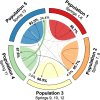Population structure and microscale morphological differentiation in a freshwater snail from the Chilean Altiplano
- PMID: 38184553
- PMCID: PMC10770964
- DOI: 10.1186/s12862-023-02196-w
Population structure and microscale morphological differentiation in a freshwater snail from the Chilean Altiplano
Abstract
Background: The diversity and population genetic structure of many species have been shaped by historical and contemporary climatic changes. For the species of the South American Altiplano, the historical climatic changes are mainly related to the wet events of great magnitude and regional influence that occurred during the Pleistocene climatic oscillations (PCOs). In contrast, contemporary climate changes are associated with events of lesser magnitude and local influence related to intensifications of the South American Summer Monsoon (SASM). Although multiple studies have analyzed the effect of PCOs on the genetic patterns of highland aquatic species, little is known about the impact of contemporary climate changes in recent evolutionary history. Therefore, in this study, we investigated the change in population structure and connectivity using nuclear and mitochondrial markers throughout the distribution range of Heleobia ascotanensis, a freshwater Cochliopidae endemic to the Ascotán Saltpan. In addition, using geometric morphometric analyses, we evaluated the concomitance of genetic divergence and morphological differentiation.
Results: The mitochondrial sequence analysis results revealed the presence of highly divergent co-distributed and geographically nested haplotypes. This pattern reflects an extension in the distribution of groups that previously would have differentiated allopatrically. These changes in distribution would have covered the entire saltpan and would be associated with the large-scale wet events of the PCOs. On the other hand, the microsatellite results defined five spatially isolated populations, separated primarily by geographic barriers. Contemporary gene flow analyses suggest that post-PCO, climatic events that would have connected all populations did not occur. The morphometric analyses results indicate that there is significant morphological differentiation in the populations that are more isolated and that present the greatest genetic divergence.
Conclusions: The contemporary population structure and morphological variation of H. ascotanensis mainly reflect the post-PCO climatic influence. Although both markers exhibit high genetic structuring, the microsatellite and morphology results show the preponderant influence of fragmentation in recent evolutionary history. The contemporary genetic pattern shows that in species that have limited dispersal capabilities, genetic discontinuities can appear rapidly, erasing signs of historical connectivity.
Keywords: Aquatic invertebrate; Fragmentation; Geometric morphometrics; Pleistocene climatic oscillations; South American summer monsoon.
© 2023. The Author(s).
Conflict of interest statement
The authors declare no competing interests.
Figures






Similar articles
-
Influenced but not determined by historical events: genetic, demographic and morphological differentiation in Heleobia ascotanensis from the Chilean Altiplano.PeerJ. 2018 Dec 17;6:e5802. doi: 10.7717/peerj.5802. eCollection 2018. PeerJ. 2018. PMID: 30588392 Free PMC article.
-
Genetic Diversity, Morphometric Characterization, and Conservation Reassessment of the Critically Endangered Freshwater Snail, Heleobia atacamensis, in the Atacama Saltpan, Northern Chile.Biology (Basel). 2023 May 30;12(6):791. doi: 10.3390/biology12060791. Biology (Basel). 2023. PMID: 37372077 Free PMC article.
-
Beringian sub-refugia revealed in blackfish (Dallia): implications for understanding the effects of Pleistocene glaciations on Beringian taxa and other Arctic aquatic fauna.BMC Evol Biol. 2015 Jul 19;15:144. doi: 10.1186/s12862-015-0413-2. BMC Evol Biol. 2015. PMID: 26187279 Free PMC article.
-
Phylogenetic and phylogeographic analysis of the genus Orestias (Teleostei: Cyprinodontidae) in the southern Chilean Altiplano: the relevance of ancient and recent divergence processes in speciation.J Fish Biol. 2013 Mar;82(3):927-43. doi: 10.1111/jfb.12031. Epub 2013 Feb 8. J Fish Biol. 2013. PMID: 23464552
-
Pleistocene climate oscillations have shaped the expansion and contraction speciation model of the globose Eriosyce sect. Neoporteria cacti in Central Chile.Ann Bot. 2024 Oct 30;134(4):651-664. doi: 10.1093/aob/mcae087. Ann Bot. 2024. PMID: 38824400 Free PMC article.
Cited by
-
Delimitation of Endangered Telmatobius Species (Anura: Telmatobiidae) of the Chilean Salt Puna.Animals (Basel). 2024 Dec 15;14(24):3612. doi: 10.3390/ani14243612. Animals (Basel). 2024. PMID: 39765516 Free PMC article.
References
-
- Argollo J, Mourguiart P. Late Quaternary climate history of the Bolivian Altiplano. Quatern Int. 2000;72:37–51. doi: 10.1016/S1040-6182(00)00019-7. - DOI
-
- Placzek CJ, Quade J, Patchett PJ. A 130ka reconstruction of rainfall on the Bolivian Altiplano. Earth Planet Sc Lett. 2013;363:97–108. doi: 10.1016/j.epsl.2012.12.017. - DOI
-
- Blard P-H, Lavé J, Farley KA, Fornari M, Jiménez N, Ramirez V. Late local glacial maximum in the central Altiplano triggered by cold and locally-wet conditions during the paleolake Tauca episode (17–15ka, Heinrich 1) Quaternary Sci Rev. 2009;28:3414–3427. doi: 10.1016/j.quascirev.2009.09.025. - DOI
-
- Lavenú A, Fornari M, Sebrier M. Existence de deux nouveaux épisodes lacustres quaternaires dans l’Altiplano Péruvo-Bolivien. Cahiers ORSTOM Série Géologie. 1984;14:103–114.
-
- Fornari M, Risacher F, Féraud G. Dating of paleolakes in the central Altiplano of Bolivia. Palaeogeogr Palaeoclim Palaeoecol. 2001;172:269–282. doi: 10.1016/S0031-0182(01)00301-7. - DOI
Publication types
MeSH terms
LinkOut - more resources
Full Text Sources
Medical
Research Materials
